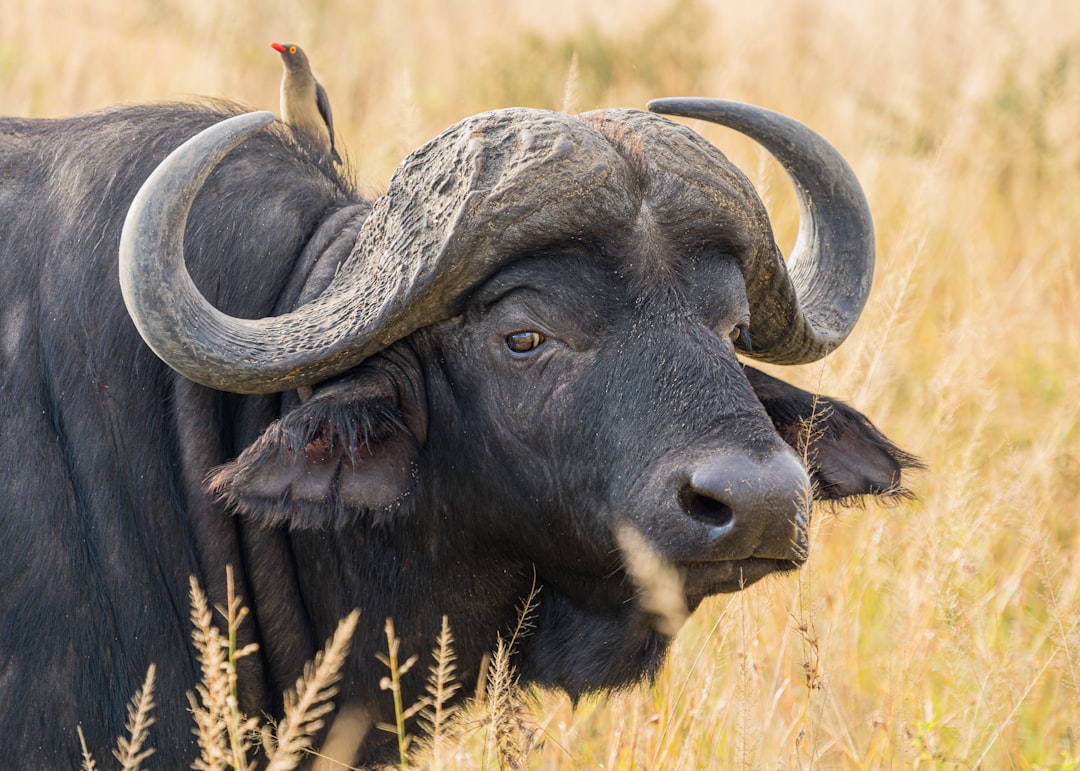Buffalo vs. Wildebeest
What's the Difference?
Buffalo and wildebeest are both large herbivorous mammals that belong to the Bovidae family. However, there are some notable differences between the two. Buffalo are known for their robust build, with a hump on their back and curved horns that can be quite intimidating. They are primarily found in Africa and Asia, and their social structure revolves around a dominant male leading a herd of females and their offspring. On the other hand, wildebeest are known for their distinctive appearance, with a large head, long face, and curved horns. They are exclusively found in Africa and are famous for their annual migration, where millions of wildebeest travel in search of fresh grazing lands. While both animals are fascinating in their own right, buffalo are more solitary and territorial, while wildebeest exhibit a more gregarious behavior, forming large herds for protection against predators.
Comparison

| Attribute | Buffalo | Wildebeest |
|---|---|---|
| Kingdom | Animalia | Animalia |
| Phylum | Chordata | Chordata |
| Class | Mammalia | Mammalia |
| Order | Artiodactyla | Artiodactyla |
| Family | Bovidae | Bovidae |
| Genus | Bubalus | Connochaetes |
| Species | Bubalus bubalis | Connochaetes taurinus |
| Habitat | Grasslands, forests, wetlands | Grasslands, savannas |
| Diet | Herbivore | Herbivore |
| Average Lifespan | 20-25 years | 20-25 years |
| Size | Large | Large |
| Weight | 800-1,200 kg | 150-250 kg |
| Speed | 30-40 mph | 50-60 mph |

Further Detail
Introduction
Buffalo and wildebeest are two iconic animals found in different parts of the world. While they may share some similarities, they also have distinct attributes that set them apart. In this article, we will explore the characteristics of both buffalo and wildebeest, including their physical appearance, behavior, habitat, and ecological significance.
Physical Appearance
Buffalo and wildebeest have noticeable differences in their physical appearance. Buffalos, also known as African buffalo or Cape buffalo, are large and robust animals with a stocky build. They have a dark brown or black coat, often with a thick layer of hair on their head and neck. Their horns are wide and curved, forming a characteristic shape. In contrast, wildebeest, also called gnus, have a more slender body structure. They have a light brown or grayish coat with vertical stripes on their sides. Their horns are shorter and more curved than those of buffalos.
Behavior
Buffalo and wildebeest exhibit different behaviors in their respective habitats. Buffalos are known for their herding behavior, often forming large groups called herds. These herds can consist of hundreds or even thousands of individuals, providing protection against predators. Buffalos are also known for their aggressive nature, especially when their herd is threatened. They can charge at high speeds and use their sharp horns to defend themselves. On the other hand, wildebeest are migratory animals that undertake long-distance movements in search of food and water. They form massive herds during migration, which can be a spectacular sight to witness.
Habitat
Buffalo and wildebeest inhabit different regions of the world, each with its unique habitat requirements. Buffalos are primarily found in sub-Saharan Africa, where they inhabit a variety of habitats such as grasslands, savannas, and woodlands. They are well-adapted to both wet and dry environments and can be found near water sources. In contrast, wildebeest are mainly found in the grassy plains and open woodlands of eastern and southern Africa. They are particularly associated with the Serengeti ecosystem, where they undertake their annual migration in search of fresh grazing lands.
Ecological Significance
Both buffalo and wildebeest play crucial roles in their respective ecosystems. Buffalos are considered a keystone species, meaning they have a disproportionately large impact on their environment compared to their abundance. They help maintain the balance of grasslands by grazing on vegetation, preventing the dominance of certain plant species. Their wallowing behavior also creates water holes that benefit other animals. Additionally, buffalos serve as prey for large predators, contributing to the overall biodiversity of their habitat. Similarly, wildebeest are an integral part of the African savanna ecosystem. Their grazing behavior helps control vegetation growth and stimulates new plant growth. They are also a vital food source for predators such as lions, hyenas, and crocodiles, supporting the intricate web of life in their habitat.
Conservation Status
Both buffalo and wildebeest face conservation challenges due to various factors. The African buffalo is currently listed as a species of least concern by the International Union for Conservation of Nature (IUCN). However, local populations can be affected by habitat loss, hunting, and diseases such as bovine tuberculosis. Efforts are being made to protect their habitats and manage their populations sustainably. On the other hand, the wildebeest is also listed as a species of least concern. However, their migration routes are threatened by human activities, including infrastructure development and land conversion. Conservation organizations are working to safeguard these critical migration corridors and ensure the long-term survival of wildebeest populations.
Conclusion
In conclusion, buffalo and wildebeest are fascinating animals with distinct attributes. While buffalo are known for their robust build, herding behavior, and aggressive nature, wildebeest are recognized for their slender bodies, migratory behavior, and association with the Serengeti ecosystem. Both species play vital roles in their respective habitats, contributing to the ecological balance and supporting a diverse array of wildlife. Conservation efforts are essential to protect these magnificent creatures and ensure their survival for future generations to appreciate and admire.
Comparisons may contain inaccurate information about people, places, or facts. Please report any issues.